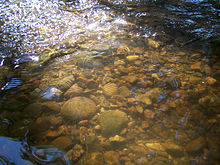Hyporheic interstitial
As hyporheisches Interstitial or shortly Hyporheal (from the Greek. Hypothermic (below) and the technical term Rheal (living space of the watercourse)), the ecological habitat of the cavity system in the from rivers deposited loose rock (the fluvial sediment designated) extending close to or below the Surface water of a running water. The zone that adjoins the hyporheic interstitial below and to the side is also called the interstitial remote from the bank.
Hyporheic interstitial as a living space
Similar to source regions , the hyporheic interstitial forms an ecological transition and exchange zone between surface water and its groundwater , with specific environmental conditions for the organisms.
The hyporheic interstitial provides important habitats for many organisms in a flowing water . In addition to many species that inhabit the bottom of the water ( benthos ) or the groundwater and spend certain phases of life here, there are also species that live exclusively or preferentially in the hyporheic interstitial. They are called "hyporheophiles" and "hyporheobionts".
Ecological and biological importance
For some fish species, so-called gravel spawners such as trout and grayling , gravel serves as a spawning area, as the eggs and juvenile fish develop in the spaces in between. The hyporheic interstitial has an important protective function for the inhabitants of the water floor. For some small organisms, e.g. B. young larvae of insects or fish, it can become a place of refuge where at least part of the population can survive. After major disturbances, such as sediment-shifting floods, the passage of a wave of pollution or drying out above ground, the flowing water can be repopulated from the hyporheic interstitial. The prerequisite for this is that the interstitial water has a good flow and a sufficiently high oxygen concentration.
Colonization and flow conditions
The colonization by suitable small organisms (e.g. rotifers , freshwater mites, juvenile larvae of aquatic insects) can extend in depth up to 70 cm below the river bed and laterally over the bank embankment. The flow speed in the hyporheic interstitial is about 1-2 percent of the surface flow speed in the direction of flow of the water.
Threat from fine sediments
The hyporheic interstitial is threatened by the increasing load of fine sediments in many bodies of water, which is mainly brought in by erosion as a result of hydraulic engineering measures. This sediment load can no longer settle in straightened rivers in still or eddy zones or in flood plains in floodplains . By sedimentation and deposits of sand or mud at the river bottom there is then a blockage of the gaps of the hyporheic interstitials as clogging is called. Because of its important role as a habitat for small animals and a “nursery” for many river fish, this can have a strong impact on the aquatic ecology as a whole and, in particular, on the success of the reintroduction of migratory fish such as salmon and sea trout.
literature
- M. Brunke, M. Mutz, J. Marxsen, C. Schmidt, S. Schmidt, JH Fleckenstein: The hyporheic interstitial of flowing waters: structures, processes and functions. In: H. Brendelberger, P. Martin, M. Brunke, HJ Hahn (eds.): Groundwater-shaped habitats - an overview of groundwater, springs, the hyporheic interstitial and other habitats. (= Limnologie Aktuell. Volume 14). E. Schweizerbart'sche Verlagsbuchhandlung, Stuttgart 2015, ISBN 978-3-510-53012-0 , pp. 133-214.
- Dietrich Uhlmann, Wolfgang Horn: Hydrobiology of inland waters. Ulmer, Stuttgart 2001, ISBN 3-8252-2206-3 .
- Wilfried Schönborn: Textbook of Limnology. Schweizerbart, Stuttgart 2003, ISBN 3-510-65204-5 .
- Jürgen Schwoerbel, Heinz Brendelberger: Introduction to Limnology. 9th edition. Elsevier, Heidelberg 2005, ISBN 3-8274-1498-9 .
Individual evidence
- ↑ Ralf Gerken: Resettlement of salmon and sea trout in the upper Wümmeg area: Practical species and water protection on streams and rivers in the lowlands. (= Natural history series of the Foundation for Nature Conservation in the Rotenburg district. Volume 3). Verlag BoD, 2006, ISBN 3-8334-4255-7 , p. 114.
